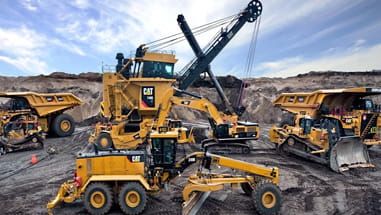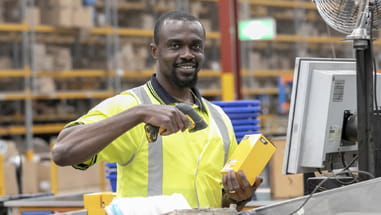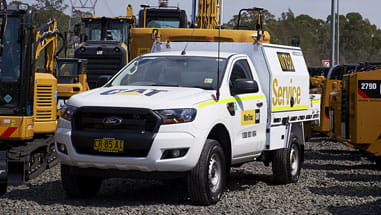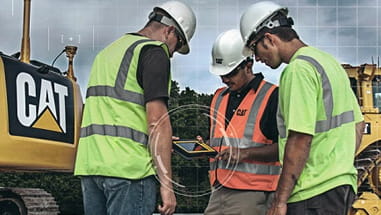With our huge inventory of new, used and rental equipment, WesTrac has the right machine for the job.
30 May 2022
While safety performance is always a key consideration when new technology and work practices are implemented in the Australian mining industry, it is not always the primary reason.
But for Rio Tinto, WesTrac and Caterpillar, a new tele-remote dozing system (TDS) at Rio Tinto’s iron ore operations in Western Australia is wholly focused on operator safety.
Rio Tinto process and technical superintendent Michelle Woolcock says the overarching brief was to effectively manage potential safety risks associated with dozers working in areas that were more susceptible to risk.
“The brief was to take the operator out of the line of fire, in particular to reduce the risks associated with slipping or stability issues, for example when they were working on stockpiles or close to steep walls,” she said.
“The solution utilises the Cat MineStar Command for Dozing technology and a dedicated operator control centre, allowing for non-line-of-site operation of dozers working in high-risk areas.
“There is also an over-the-shoulder console which allows operators to work within visual range, typically used for temporary or one-off movements of machines. “The remote operator control centre is similar to a simulator with all the in-cab controls replicated. Rio Tinto’s also incorporates a vision kit, making use of four cameras on board each dozer and relaying machine information and visuals in real time via a WiFi network.”
Rio Tinto operational readiness superintendent Jamie Webster said the initial rollout of the TDS at the Cape Lambert Port facility north-east of Karratha was focused on high-risk operations on coarse ore stockpiles with steep gradients and “live” areas where ore is fed into underground tunnels.
“These dozers are operating in quite a tight area around lots of fixed assets,” he said.
“That means work is quite intricate and the real benefits will be realised in pushing ore from the stockpiles into the live zones.
“The dozers are working at the top of a large stockpile and if a dozer slips it could go down a bank, or if it’s working while the apron feeder is operating, the ground could fall away from underneath it.
“Obviously, we already have processes in place and technology to mitigate such risks but putting the operators into a station away from the danger zones eliminates any potential risk of harm, no matter how small that risk might be.”
While removing operators from high-risk zones is driving the rollout of the solution, Woolcock says it does not mean removing operators from site.
She says remote operators still need to be “close to the action” and have detailed site knowledge to function most effectively and efficiently.
“As much as ‘non-line-of-site’ operation sounds like it could be carried out from anywhere, the reality is that these operators are multitasking in their roles,” she said.
“It will depend on the state of the coarse ore stockpile and what’s coming in and going out. They need to be able to visually inspect and determine what needs to be done.
“They might spend an hour or two dozing then move on to other tasks while they wait for the stockpiles to be replenished.
“When you need dozer operators, you typically need all hands on deck, and when you don’t need them, if they’re sitting in a control centre hundreds of kilometres away, it’s far more difficult to stay on top of other tasks they might carry out on site.”
Woolcock and Webster said there was some resistance among the first trainees, but as operators became more familiar with the solution, they embraced it.
“A lot of operators quite literally work the dozers through their seats,” Webster said.
“They might have worked for decades and are accustomed to feeling the movement. So they’re having to relearn how to drive the dozer without that sense of movement, and they’re relying entirely on the visual feed of information rather than the other senses from being in the mobile rig.”
WesTrac mining technology product manager Gary Scott said the Cape Lambert project provided an ideal proving ground to develop rollout strategies that can be extended to other sites.
“Every site and situation is obviously going to have some unique aspects, but there is a set of core requirements that will apply across all implementations,” he said.
“It starts with an audit on the available machines to understand the current capabilities, then we can define the technology requirements to be fitted to those machines.
“Across an operation like Rio Tinto’s, we’d typically expect to see a fair bit of consistency but there may still be differences based on the age of the site and the asset maintenance and replacement schedules.
“The system readily interacts with other Cat control systems including MineStar Terrain, so we can set up working parameters including geofencing and avoidance zones.”
Those operating parameters and control solutions will be vital as the TDS technology is rolled out across Rio Tinto’s mine sites, including its new Gudai-Darri mine.
When production commences this year, the site will be one of the most technologically advanced mines in the world and will feature a large fleet of autonomous haul trucks, water carts and drill rigs.
In such environments, any manually controlled equipment, whether in-cab or remotely operated, must be equipped to interact with autonomous machines.
While every aspect of the TDS technology and the way it interacts with other equipment is safety focused, Wenster expects that in time the operations will see productivity gains too.
“There’s still a lot to understand about how we can be the most productive with this system,” he said.
“As we’re learning and developing, and as everyone becomes more familiar with the new way of operating, the added comfort and control will lead to operators being even more productive than we are today.”
Authorised Images
- Download - "Cat D11 dozer at Cape Lambert from a distance"
- Download - "Cat D11 dozer at Cape Lambert up close"
WesTrac Media Contact
Spoke
Marissa Taddeo
marissa@hellospoke.com.au
0401 019 885
Emily Evans
emily@hellospoke.com.au
0401 337 959
About WesTrac
As one of the largest authorised Cat equipment dealers in the world, WesTrac provides customers with a wide range of mining and construction equipment as well as comprehensive whole-of-life management solutions designed to make owning and operating equipment as easy, profitable and safe as possible. With more than 4,500 staff, WesTrac is focused on long-term customer relationships and a dedication to customer service, safety, quality and the environment.
To achieve this, we commit to building better together through collaboration and collective action. Helping customers achieve their own ESG objectives to reduce emissions through product advancements and technology solutions. This shared goal of a sustainable future for all is why we are focused on Responsibility, Advancement, Community, Inclusivity, Development and Solutions, as a means to deliver long-term positive success for the environment, customers, team members, stakeholders and the wider community.
Community development and support is an important part of the WesTrac philosophy, and we are proud to support local activities, events and charities in the regions we are based. As part of SGH Ltd, WesTrac also has strong alliances with other leading Australian businesses, including Seven West Media, Boral, Coates and SITECH.




